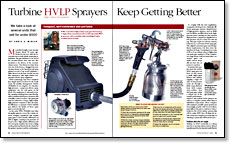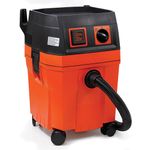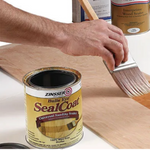Turbine HVLP Sprayers Keep Getting Better
We take a look at several units that sell for under $500
Synopsis: Chris A. Minick inspects five high-volume, low-pressure spray units to see how they handle in the woodshop. He researched their history and shares tips on how to select one. He evaluated each model’s pros and cons and compares turbine information (amps, stages, diameter), air output (per manufacturer, measured at hose and at gun), air pressure (per manufacturer, maximum and atomization), and temperature (measured at hose and gun air cap) performance. He looks at spray-gun information, including type, hose connection, fluid nozzle oriface size, gun body, gun cup, air-reducing valve, transfer efficiency, overspray, and atomization. These sprayers are compact, self-contained, and portable.
My mother bought a new vacuum cleaner about 40 years ago. Packed in the box with the accessories was a crude, plastic spray-gun attachment. The gun attached to one end of the vacuum-cleaner hose that was also mounted to the blower of the vacuum cleaner motor. One afternoon when Mom was out of the house, I dragged her new vacuum cleaner to the basement and spray painted several of my model airplanes. I didn’t know it at the time, but this was my first experience with high-volume low pressure (HVLP) spray equipment.
HVLP technology may have remained that simple had it not been for the South Coast Air Quality Management District (SCAQMD) in Los Angeles. For decades, high-pressure, compressor-driven spray equipment was the only game on the block. The equipment is extremely versatile, spraying anything from water-thin liquids to molasses-thick paste. However, this versatility comes at a price: The spray gun must be tethered to a large, high-output, high-pressure compressor. Also, the transfer efficiency—a measure of how well the gun delivers the finish—of these spray guns is notoriously bad.
In the early 1980s, SCAQMD and other air-quality agencies across the country enacted stringent regulations that require spray guns to have transfer efficiencies of 65% or higher, running at air pressures of 10 psi or less. High transfer efficiency and low overspray translate into more coating on the project and less in the air—better for the sprayer operator and the environment.
To comply with the new regulations, companies developed two distinctly different spray-gun systems. Manufacturers of high-pressure sprayers, such as Binks and DeVilbiss, modified their basic high pressure guns, creating one that converts high-pressure, compressor-supplied air to low-pressure (10 psi or less) air at the air cap. This type of gun, for obvious reasons, is known as a conversion HVLP spray gun. The original conversion guns met all regulatory requirements, but they were tremendous air hogs. Consuming air at a rate of 20 cu. ft. per minute (cfm) or higher, just one spray gun required a 10-hp compressor. Large shops could accommodate conversion guns, but small, custom shops did not have the air power to run them.
To answer that market need, the turbine HVLP spray gun was born. In this system a small, high-output blower (the turbine) supplies a high volume of low-pressure warm air through a fairly large-diameter hose. Each component—turbine, hose and spray gun—plays a critical role in the overall performance, which is why turbine HVLP sprayers are sold as a complete system rather than as individual components.
From Fine Woodworking #137
For the full article, download the PDF below:
Fine Woodworking Recommended Products

Fein Turbo II HEPA Wet/Dry Dust Extractor


Odie's Oil























Log in or create an account to post a comment.
Sign up Log in